Rural Effectiveness Evaluation: A New Way of Assessing Village Development Status
Abstract
:1. Introduction
2. Theoretical Framework
3. Materials and Methods
3.1. Study Area
3.2. Data Sources
3.3. Construction of Function Measurement Indicator System
3.3.1. Production Effectiveness
3.3.2. Living Effectiveness
3.3.3. Ecological Effectiveness
3.4. Effectiveness Measurement Methodology
3.4.1. Standardization of Data for Function Evaluation Indicators
3.4.2. Functional Measurement Model
3.4.3. Efficiency Measurement Methods
3.4.4. Village Effectiveness Matching Model
3.4.5. Classification Model for Effectiveness Dominant Types
3.4.6. Quantitative Evaluation Model of Effectiveness Intensity
3.4.7. Evaluation Model of Effectiveness Internal Relationship Analysis Model
4. Results
4.1. Village Function and Efficiency Evaluation Results
4.1.1. Village Function Evaluation Results
4.1.2. Village Efficiency Evaluation Results
4.2. Effectiveness Matching Results
4.3. Results of the Classification of Effectiveness Dominant Types
4.4. Results of Effectiveness Intensity Measurements
4.5. Analysis of Interactions within Effectiveness
5. Discussion
6. Conclusions
- (1)
- We evaluated a total of 791 villages in Xintai county, of which 220 villages were found to have comprehensive effectiveness, accounting for 27.8% of the total, and the high-value areas were found to mainly be distributed in the central urban and sub-administrative center of Xintai county. The number of villages with effectiveness in the production dimension was rather limited, with only 204 villages accounting for 25.7% of all assessment objects, and the high value of their location same as the comprehensive effectiveness. There were 229 villages with high living effectiveness, accounting for 28.9% of all villages, and the high-value geographical distribution was concentrated in the county center. The ecological dimension had the largest number villages, with 195, accounting for 24.7% of the total, and their high-value spatial distribution was mostly in eastern mountainous areas.
- (2)
- The primary categories of village effectiveness were identified. In terms of production, 119 villages were function-dominant, and 85 villages were efficiency-dominant, suggesting that the region has a strong industrial basis. The efficiency-dominant type is primarily found outside of the central city, confirming the impact of industrial transformation and the urban sprawl; in the living dimension, there were 226 function-dominant types and 3 efficiency-dominant types, indicating that the region’s background conditions for living facilities are good due to the region’s original industrial base, but the efficiency of living facility allocation is generally low. There were 148 function-dominant type villages and 47 efficiency-dominant type villages in the ecological dimension, with the function-dominant type villages being more common. Loude Town was the region that has increased its efforts to manage the ecological environment. In the comprehensive dimension, there were 176 function-dominant type villages and 44 efficiency-dominant type villages.
- (3)
- The study’s findings revealed a negative association between function and efficiency in the same dimension, implying that a better resource background scenario frequently leads to an imbalance in resource allocation and a low output level, which has a detrimental influence on the village’s long-term sustainability. At the same time, there are some trade-offs and synergies between the three dimensions of production, living, and ecology, such as the trade-offs between production and ecological function, and production function and living efficiency, as well as ecological function and production efficiency, and production and ecological efficiency, all of which indicate a contradiction between human activities and the ecological environment. There are synergies between production function and ecological efficiency, production efficiency and living efficiency, and living efficiency and ecological efficiency, indicating the transformation development of regional industries; as part of the process of economic growth, the residents have caused an increase in the renovation of habitats and the protection of the ecological environment.
Author Contributions
Funding
Institutional Review Board Statement
Informed Consent Statement
Data Availability Statement
Acknowledgments
Conflicts of Interest
Appendix A
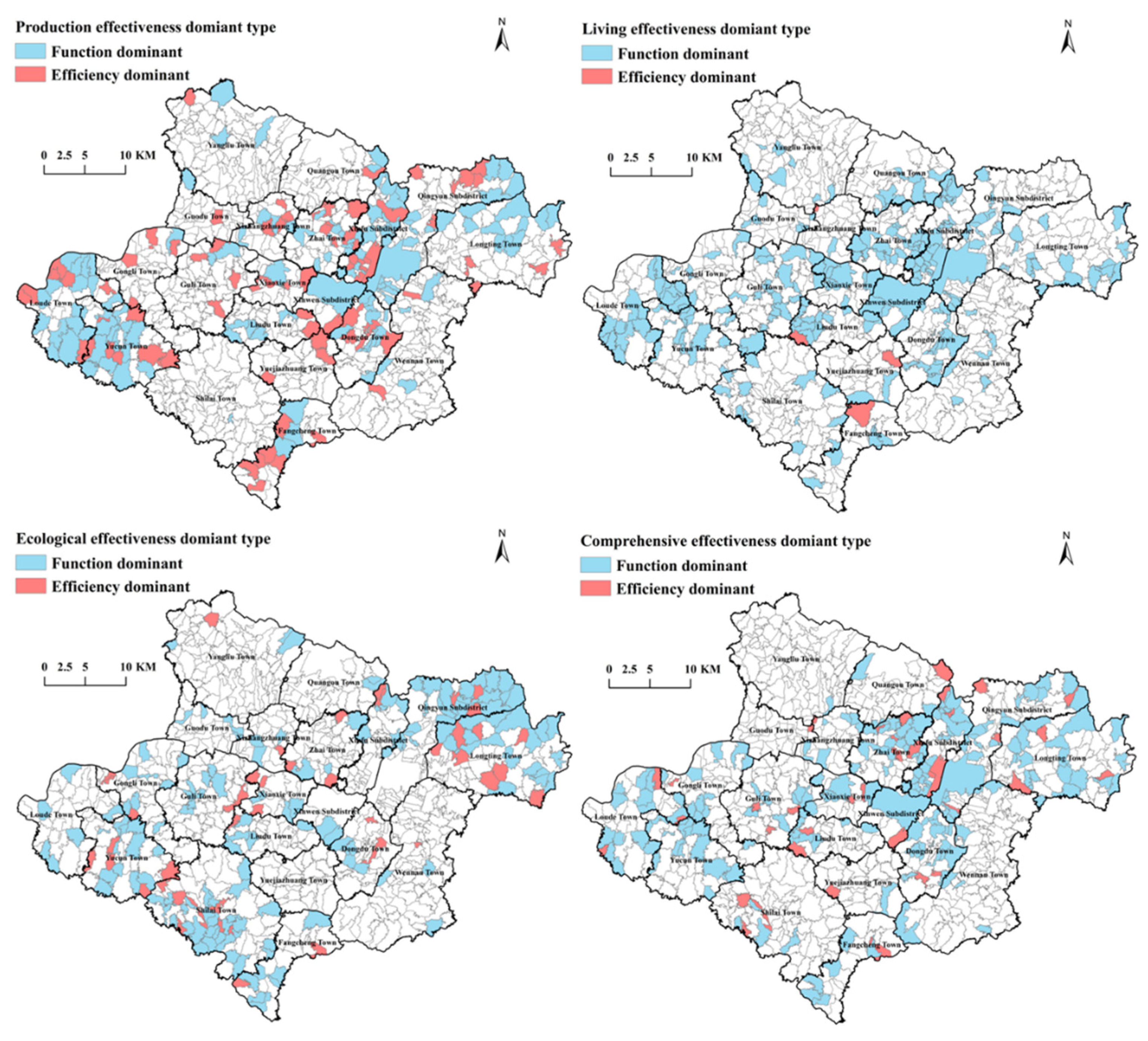
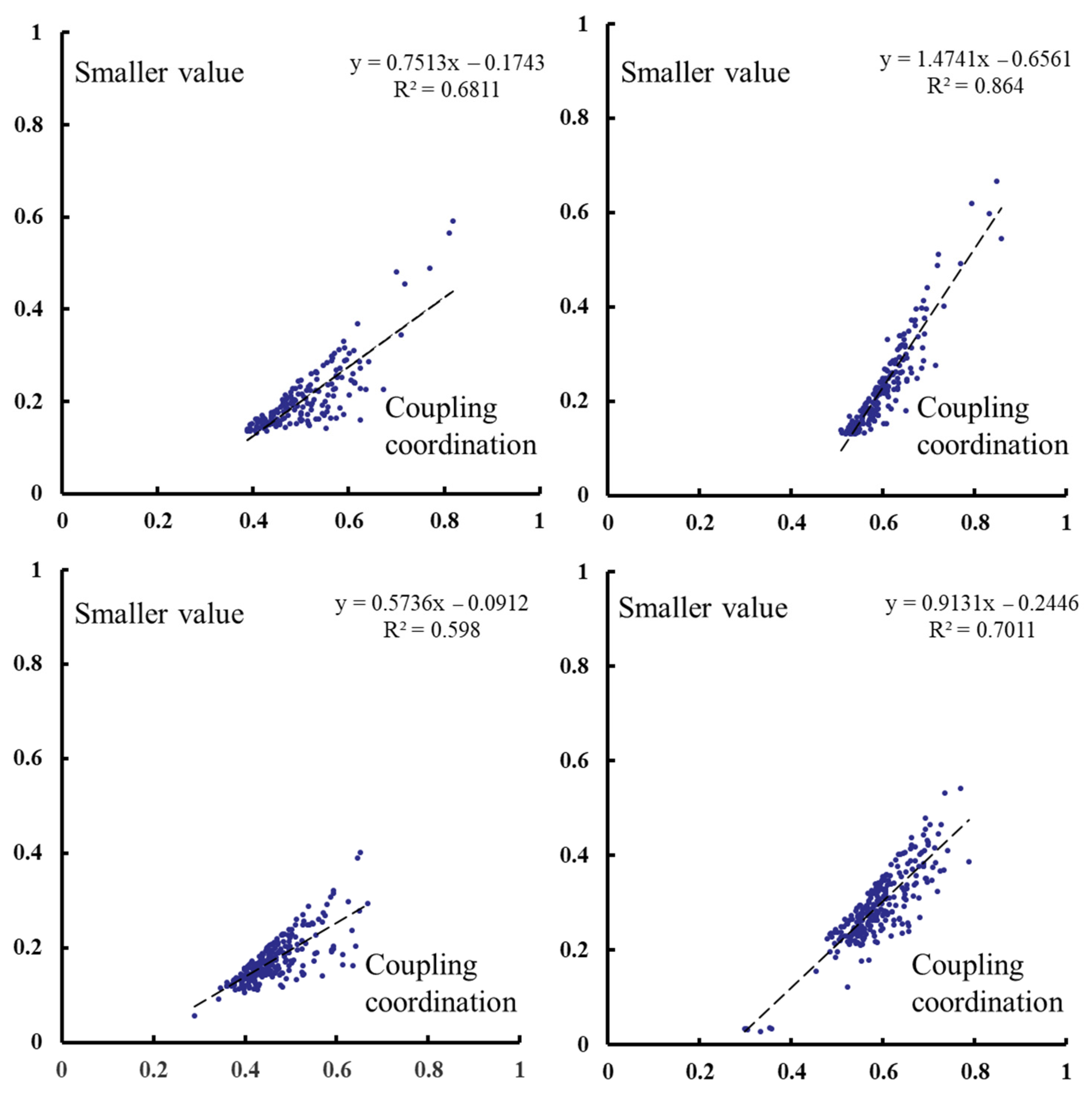

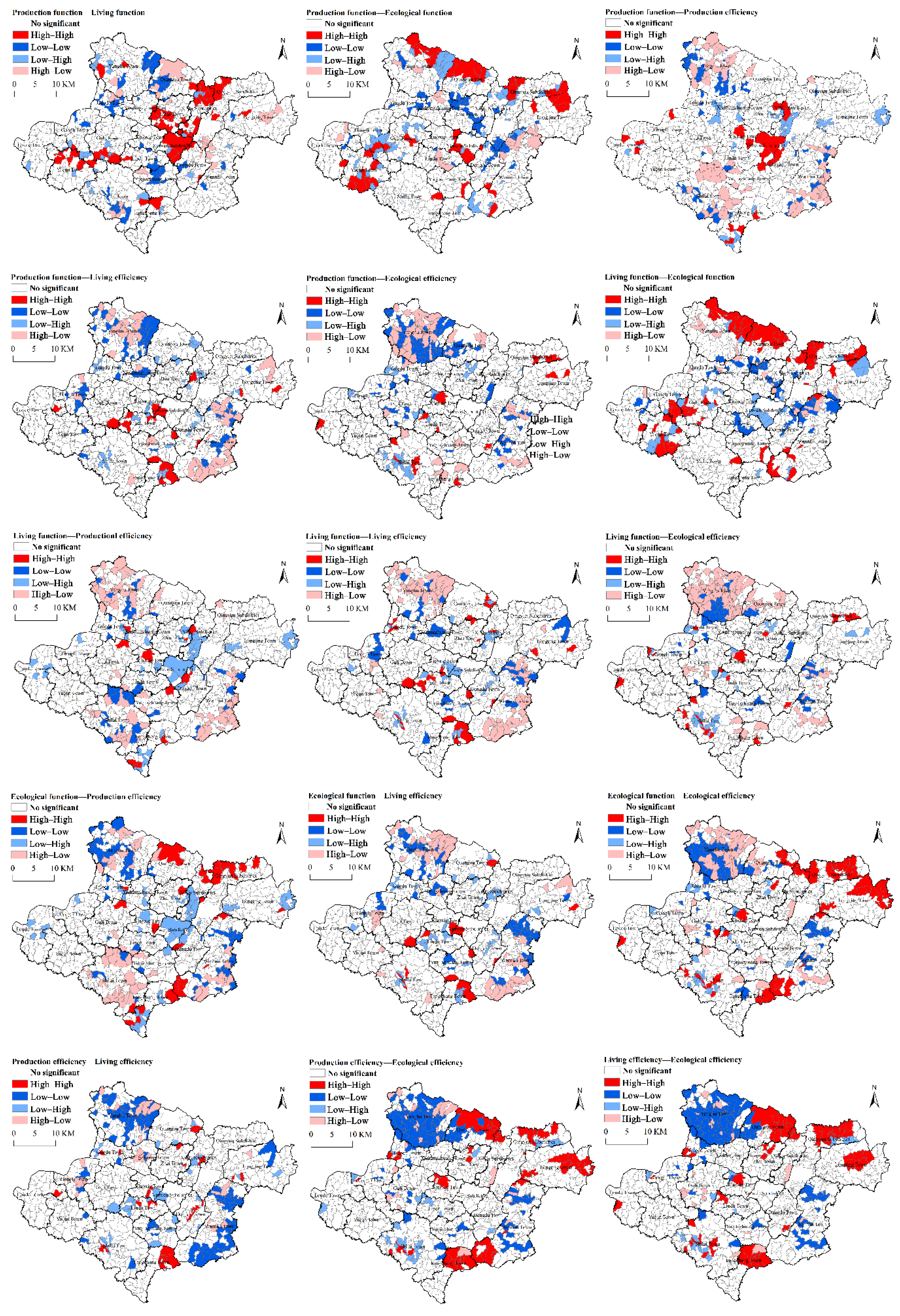
References
- Zhou, Y.; Shen, Y.; Yang, X.; Wang, Z.; Xu, L. Where to Revitalize, and How? A Rural Typology Zoning for China. Land 2021, 10, 1336. [Google Scholar] [CrossRef]
- Zhu, C.; Zhang, X.; Wang, K.; Yuan, S.; Yang, L.; Skitmore, M. Urban–rural construction land transition and its coupling relationship with population flow in China’s urban agglomeration region. Cities 2020, 101, 102701. [Google Scholar] [CrossRef]
- Amartuvshin, A.; Chen, J.; John, R.; Zhang, Y.; Lkhagvaa, D. How does mining policy affect rural migration of Mongolia? Land Use Policy 2021, 107, 105474. [Google Scholar] [CrossRef]
- Liu, Y.; Li, Y. Revitalize the world’s countryside. Nature 2017, 548, 275–277. [Google Scholar] [CrossRef]
- Pompeu, J.; Soler, L.; Ometto, J. Modelling Land Sharing and Land Sparing Relationship with Rural Population in the Cerrado. Land 2018, 7, 88. [Google Scholar] [CrossRef] [Green Version]
- Li, Y.; Jia, L.; Wu, W.; Yan, J.; Liu, Y. Urbanization for rural sustainability—Rethinking China’s urbanization strategy. J. Clean. Prod. 2018, 178, 580–586. [Google Scholar] [CrossRef]
- Li, Y.; Liu, Y.; Long, H.; Cui, W. Community-based rural residential land consolidation and allocation can help to revitalize hollowed villages in traditional agricultural areas of China: Evidence from Dancheng County, Henan Province. Land Use Policy 2014, 39, 188–198. [Google Scholar] [CrossRef]
- Li, Y.; Westlund, H.; Liu, Y. Why some rural areas decline while some others not: An overview of rural evolution in the world. J. Rural Stud. 2019, 68, 135–143. [Google Scholar] [CrossRef]
- Gu, X.; Xie, B.; Zhang, Z.; Guo, H. Rural multifunction in Shanghai suburbs: Evaluation and spatial characteristics based on villages. Habitat Int. 2019, 92, 102041. [Google Scholar] [CrossRef]
- Meng, J.; Cheng, H.; Li, F.; Han, Z.; Wei, C.; Wu, Y.; You, N.W.; Zhu, L. Spatial-temporal trade-offs of land multi-functionality and function zoning at finer township scale in the middle reaches of the Heihe River. Land Use Policy 2022, 115, 106019. [Google Scholar] [CrossRef]
- Qiu, Y.; Sheng, J.; He, X. An Analysis on Urban Land Use Efficiency Based on Super-efficiency DEA. J. Phys. Conf. Ser. 2021, 1873, 012051. [Google Scholar] [CrossRef]
- Noura, A.A.; Hosseinzadeh Lotfi, F.; Jahanshahloo, G.R.; Fanati Rashidi, S. Super-efficiency in DEA by effectiveness of each unit in society. Appl. Math. Lett. 2011, 24, 623–626. [Google Scholar] [CrossRef] [Green Version]
- Lyu, Y.; Wang, M.; Zou, Y.; Wu, C. Mapping trade-offs among urban fringe land use functions to accurately support spatial planning. Sci. Total Environ. 2022, 802, 149915. [Google Scholar] [CrossRef] [PubMed]
- Du, Y.-W.; Jiang, J.; Li, C.-H. Ecological efficiency evaluation of marine ranching based on the Super-SBM model: A case study of Shandong. Ecol. Indic. 2021, 131, 108174. [Google Scholar] [CrossRef]
- Qu, Y.; Jiang, G.; Shang, R.; Gao, Y. Intensive using evaluation of rural residential land based on input-output theory. Nongye Gongcheng Xuebao/Trans. Chin. Soc. Agric. Eng. 2014, 30, 221–231. [Google Scholar]
- Ma, W.; Jiang, G.; Li, W.; Zhou, T. How do population decline, urban sprawl and industrial transformation impact land use change in rural residential areas? A comparative regional analysis at the peri-urban interface. J. Clean. Prod. 2018, 205, 76–85. [Google Scholar] [CrossRef]
- Charnes, A.; Cooper, W.W.; Rhodes, E. Measuring the efficiency of decision making units. Eur. J. Oper. Res. 1978, 2, 429–444. [Google Scholar] [CrossRef]
- Kang, Y.C.; Choi, N. Understanding the effectiveness of performance management system. Polic. Int. J. 2019, 42, 847–862. [Google Scholar] [CrossRef]
- Namsrai, O.; Ochir, A.; Baast, O.; van Genderen, J.L.; Muhar, A.; Erdeni, S.; Wang, J.; Davaasuren, D.; Chonokhuu, S. Evaluating the management effectiveness of protected areas in Mongolia using the management effectiveness tracking tool. Environ. Manag. 2019, 63, 249–259. [Google Scholar] [CrossRef]
- Ekpodessi, S.G.N.; Nakamura, H. Land use and management in Benin Republic: An evaluation of the effectiveness of Land Law 2013-01. Land Use Policy 2018, 78, 61–69. [Google Scholar] [CrossRef]
- He, T.; Qiao, W.; Jia, K.; Chai, Y.; Hu, Y.; Sun, P.; Wang, Y.; Feng, T.; Li, Q. Selecting Rural Development Paths Based on Village Multifunction: A Case of Jingjiang City, China. Complexity 2020, 2020, 7590942. [Google Scholar] [CrossRef]
- Balta, S.; Atik, M. Rural planning guidelines for urban-rural transition zones as a tool for the protection of rural landscape characters and retaining urban sprawl: Antalya case from Mediterranean. Land Use Policy 2022, 119, 106144. [Google Scholar] [CrossRef]
- Cao, Y.; Bai, Z.; Sun, Q.; Zhou, W. Rural settlement changes in compound land use areas: Characteristics and reasons of changes in a mixed mining-rural-settlement area in Shanxi Province, China. Habitat Int. 2017, 61, 9–21. [Google Scholar] [CrossRef]
- Chen, H.; Zhao, L.; Zhao, Z. Influencing factors of farmers’ willingness to withdraw from rural homesteads: A survey in zhejiang, China. Land Use Policy 2017, 68, 524–530. [Google Scholar] [CrossRef]
- Yurui, L.; Luyin, Q.; Qianyi, W.; Karácsonyi, D. Towards the evaluation of rural livability in China: Theoretical framework and empirical case study. Habitat Int. 2020, 105, 102241. [Google Scholar] [CrossRef]
- Song, W.; Li, H. Spatial pattern evolution of rural settlements from 1961 to 2030 in Tongzhou District, China. Land Use Policy 2020, 99, 105044. [Google Scholar] [CrossRef]
- Tao, Z.; Guanghui, J.; Wenqiu, M.; Guangyong, L.; Yanbo, Q.; Yingying, T.; Qinglei, Z.; Yaya, T. Dying villages to prosperous villages: A perspective from revitalization of idle rural residential land (IRRL). J. Rural Stud. 2021, 84, 45–54. [Google Scholar] [CrossRef]
- Shi, M.; Xie, Y.; Cao, Q. Spatiotemporal Changes in Rural Settlement Land and Rural Population in the Middle Basin of the Heihe River, China. Sustainability 2016, 8, 614. [Google Scholar] [CrossRef] [Green Version]
- Yang, X.; Shang, G. Smallholders’ Agricultural Production Efficiency of Conservation Tillage in Jianghan Plain, China—Based on a Three-Stage DEA Model. Int. J. Environ. Res. Public Health 2020, 17, 7470. [Google Scholar] [CrossRef]
- Ren, K. Following Rural Functions to Classify Rural Sites: An Application in Jixi, Anhui Province, China. Land 2021, 10, 418. [Google Scholar] [CrossRef]
- Lynde, C.; Richmond, J. Productivity and efficiency in the UK: A time series application of DEA. Econ. Model. 1999, 16, 105–122. [Google Scholar] [CrossRef]
- Zou, L.; Liu, Y.; Yang, J.; Yang, S.; Wang, Y.; Cao, z.; Hu, X. Quantitative identification and spatial analysis of land use ecological-production-living functions in rural areas on China’s southeast coast. Habitat Int. 2020, 100, 102182. [Google Scholar] [CrossRef]
- Dai, Z.; Guo, L.; Jiang, Z. Study on the industrial Eco-Efficiency in East China based on the Super Efficiency DEA Model: An example of the 2003–2013 panel data. Appl. Econ. 2016, 48, 5779–5785. [Google Scholar] [CrossRef]
- Dong, G.; Zhang, W.; Xu, X.; Jia, K. Multi-Dimensional Feature Recognition and Policy Implications of Rural Human–Land Relationships in China. Land 2021, 10, 1086. [Google Scholar] [CrossRef]
- Charnes, A.; Cooper, W.W.; Li, S. Using data envelopment analysis to evaluate efficiency in the economic performance of Chinese cities. Socio-Econ. Plan. Sci. 1989, 23, 325–344. [Google Scholar] [CrossRef]
- Farrell, M.J. The Measurement of Productive Efficiency. J. R. Stat. Soc. Ser. A (Gen.) 1957, 120, 253–290. [Google Scholar] [CrossRef]
- Li, X.; Lu, Z.; Hou, Y.; Zhao, G.; Zhang, L. The coupling coordination degree between urbanization and air environment in the Beijing(Jing)-Tianjin(Jin)-Hebei(Ji) urban agglomeration. Ecol. Indic. 2022, 137, 108787. [Google Scholar] [CrossRef]
- Ge, K.; Zou, S.; Lu, X.; Ke, S.; Chen, D.; Liu, Z. Dynamic Evolution and the Mechanism behind the Coupling Coordination Relationship between Industrial Integration and Urban Land-Use Efficiency: A Case Study of the Yangtze River Economic Zone in China. Land 2022, 11, 261. [Google Scholar] [CrossRef]
- Liu, C.; Xu, Y.; Lu, X.; Han, J. Trade-offs and driving forces of land use functions in ecologically fragile areas of northern Hebei Province: Spatiotemporal analysis. Land Use Policy 2021, 104, 105387. [Google Scholar] [CrossRef]
- Ma, W.; Jiang, G.; Li, W.; Zhou, T.; Zhang, R. Multifunctionality assessment of the land use system in rural residential areas: Confronting land use supply with rural sustainability demand. J. Environ. Manag. 2019, 231, 73–85. [Google Scholar] [CrossRef]
- Chi, G.; Ho, H.C. Population stress: A spatiotemporal analysis of population change and land development at the county level in the contiguous United States, 2001–2011. Land Use Policy 2018, 70, 128–137. [Google Scholar] [CrossRef] [PubMed]
- Elshof, H.; Bailey, A. The role of responses to experiences of rural population decline in the social capital of families. J. Rural Community Dev 2015, 10, 72–93. [Google Scholar]
- Gao, J.; Jiang, W.; Chen, J.; Liu, Y. Housing-industry symbiosis in rural China: A multi-scalar analysis through the lens of land use. Appl. Geogr. 2020, 124, 102281. [Google Scholar] [CrossRef]
- Ge, D.; Zhou, G.; Qiao, W.; Yang, M. Land use transition and rural spatial governance: Mechanism, framework and perspectives. J. Geogr. Sci. 2020, 30, 1325–1340. [Google Scholar] [CrossRef]
- Gong, J.; Jian, Y.; Chen, W.; Liu, Y.; Hu, Y. Transitions in rural settlements and implications for rural revitalization in Guangdong Province. J. Rural Stud. 2022, 93, 359–366. [Google Scholar] [CrossRef]
- Graymore, M.L.M.; Sipe, N.G.; Rickson, R.E. Sustaining Human Carrying Capacity: A tool for regional sustainability assessment. Ecol. Econ. 2010, 69, 459–468. [Google Scholar] [CrossRef]
- Heiland, S.; May, A.; Scherfose, V. Evaluation of the Management Effectiveness of German National Parks—Experiences, Results, Lessons Learned and Future Prospects. Sustainability 2020, 12, 7135. [Google Scholar] [CrossRef]
- Shkaruba, A.; Kireyeu, V. Recognising ecological and institutional landscapes in adaptive governance of natural resources. For. Policy Econ. 2013, 36, 87–97. [Google Scholar] [CrossRef]
- Kristensen, S.B.P.; Busck, A.G.; van der Sluis, T.; Gaube, V. Patterns and drivers of farm-level land use change in selected European rural landscapes. Land Use Policy 2016, 57, 786–799. [Google Scholar] [CrossRef]
- Huang, D.; Lang, Y.; Liu, T. The Evolving Structure of Rural Construction Land in Urbanizing China: Case Study of Tai’an Prefecture. Land 2021, 10, 65. [Google Scholar] [CrossRef]
- Jia, K.; Qiao, W.; Chai, Y.; Feng, T.; Wang, Y.; Ge, D. Spatial distribution characteristics of rural settlements under diversified rural production functions: A case of Taizhou, China. Habitat Int. 2020, 102, 102201. [Google Scholar] [CrossRef]
- Le Bivic, C.; Melot, R. Scheduling urbanization in rural municipalities: Local practices in land-use planning on the fringes of the Paris region. Land Use Policy 2020, 99, 105040. [Google Scholar] [CrossRef]
- Koroso, N.H.; Lengoiboni, M.; Zevenbergen, J.A. Urbanization and urban land use efficiency: Evidence from regional and Addis Ababa satellite cities, Ethiopia. Habitat Int. 2021, 117, 102437. [Google Scholar] [CrossRef]
- Shkaruba, A.; Kireyeu, V.; Likhacheva, O. Rural–urban peripheries under socioeconomic transitions: Changing planning contexts, lasting legacies, and growing pressure. Landsc. Urban Plan. 2017, 165, 244–255. [Google Scholar] [CrossRef]
- Li, X.; Yang, H.; Jia, J.; Shen, Y.; Liu, J. Index system of sustainable rural development based on the concept of ecological livability. Environ. Impact Assess. Rev. 2021, 86, 106478. [Google Scholar] [CrossRef]
- Munthali, M.G.; Davis, N.; Adeola, A.M.; Botai, J.O. The impacts of land use and land cover dynamics on natural resources and rural livelihoods in Dedza District, Malawi. Geocarto Int. 2022, 37, 1529–1546. [Google Scholar] [CrossRef]
- Ma, X.; Liu, Y.; Wei, X.; Li, Y.; Zheng, M.; Li, Y.; Cheng, C.; Wu, Y.; Liu, Z.; Yu, Y. Measurement and decomposition of energy efficiency of Northeast China—Based on super efficiency DEA model and Malmquist index. Environ. Sci. Pollut. Res. 2017, 24, 19859–19873. [Google Scholar] [CrossRef]
- Qu, Y.; Zhan, L.; Jiang, G.; Ma, W.; Dong, X. How to Address “Population Decline and Land Expansion (PDLE)” of rural residential areas in the process of Urbanization:A comparative regional analysis of human-land interaction in Shandong Province. Habitat Int. 2021, 117, 102441. [Google Scholar] [CrossRef]
- Shi, L.; Wang, Y. Evolution characteristics and driving factors of negative decoupled rural residential land and resident population in the Yellow River Basin. Land Use Policy 2021, 109, 105685. [Google Scholar] [CrossRef]
- Li, Y.; Li, Y.; Westlund, H.; Liu, Y. Urban-rural transformation in relation to cultivated land conversion in China: Implications for optimizing land use and balanced regional development. Land Use Policy 2015, 47, 218–224. [Google Scholar] [CrossRef]
- Liu, Y. Introduction to land use and rural sustainability in China. Land Use Policy 2018, 74, 1–4. [Google Scholar] [CrossRef]
- Wu, Y.; Que, W.; Liu, Y.-G.; Li, J.; Cao, L.; Liu, S.-B.; Zeng, G.-M.; Zhang, J. Efficiency estimation of urban metabolism via Emergy, DEA of time-series. Ecol. Indic. 2018, 85, 276–284. [Google Scholar] [CrossRef]
- Zhou, T.; Jiang, G.; Zhang, R.; Zheng, Q.; Ma, W.; Zhao, Q.; Li, Y. Addressing the rural in situ urbanization (RISU) in the Beijing–Tianjin–Hebei region: Spatio-temporal pattern and driving mechanism. Cities 2018, 75, 59–71. [Google Scholar] [CrossRef]
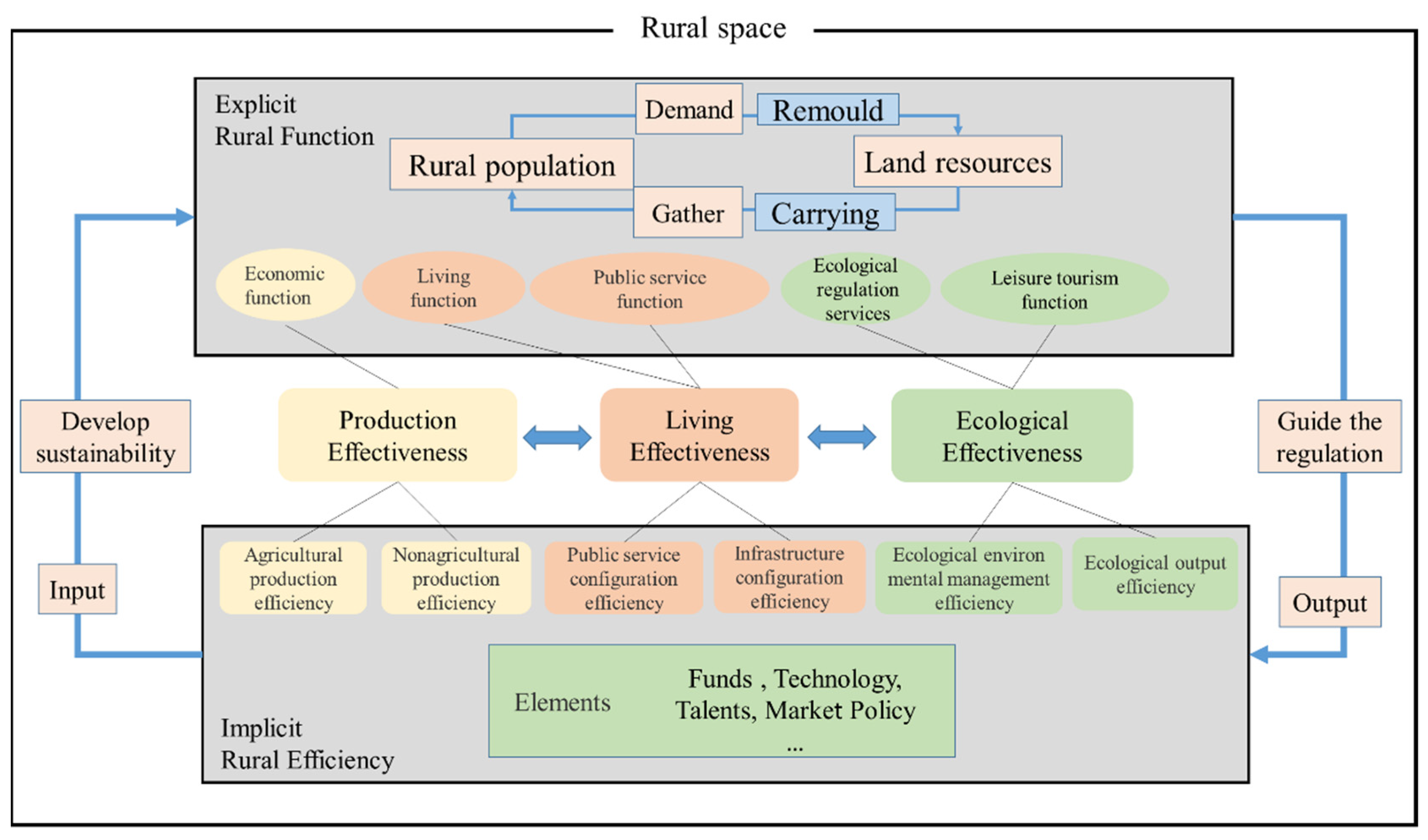

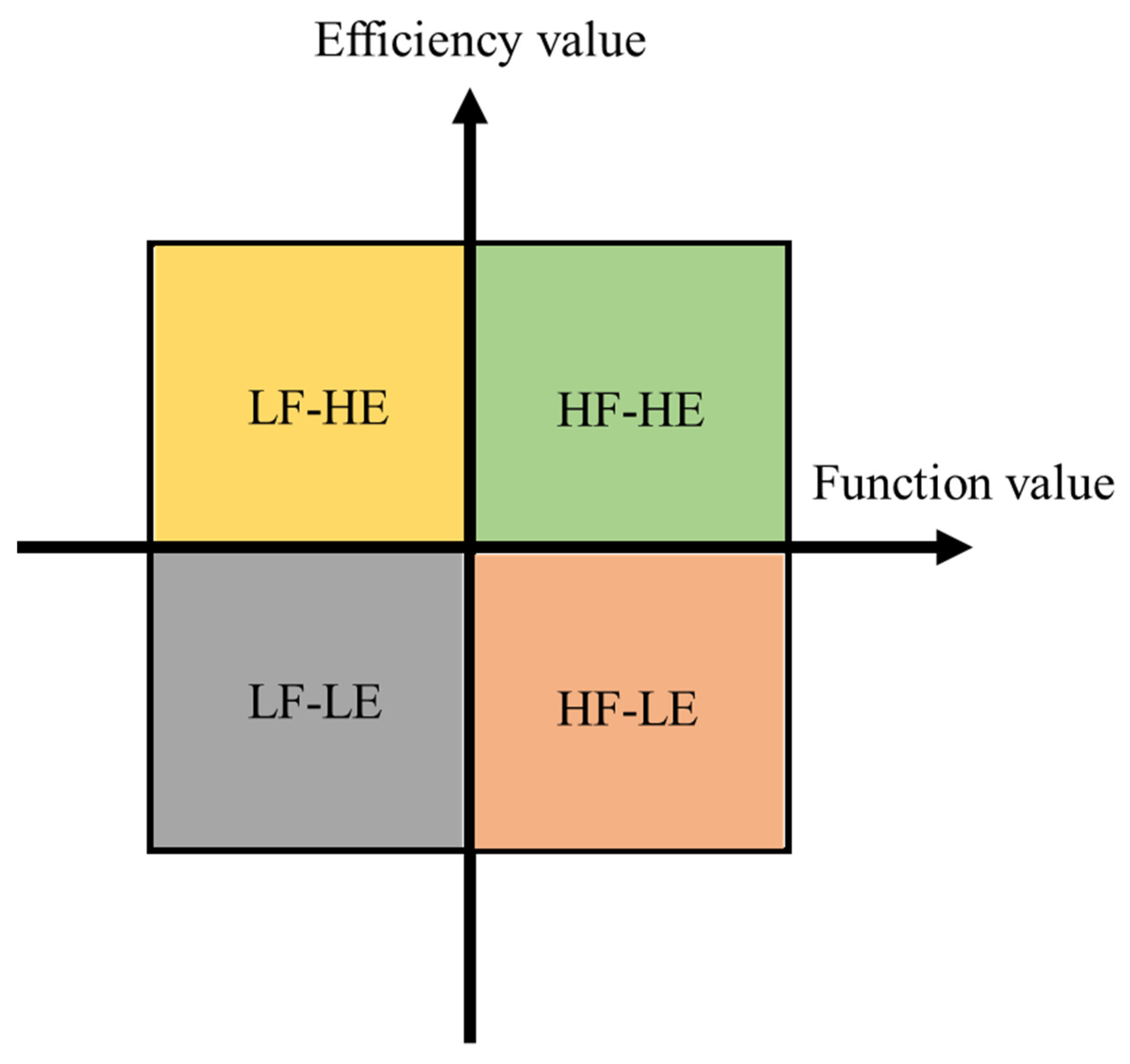

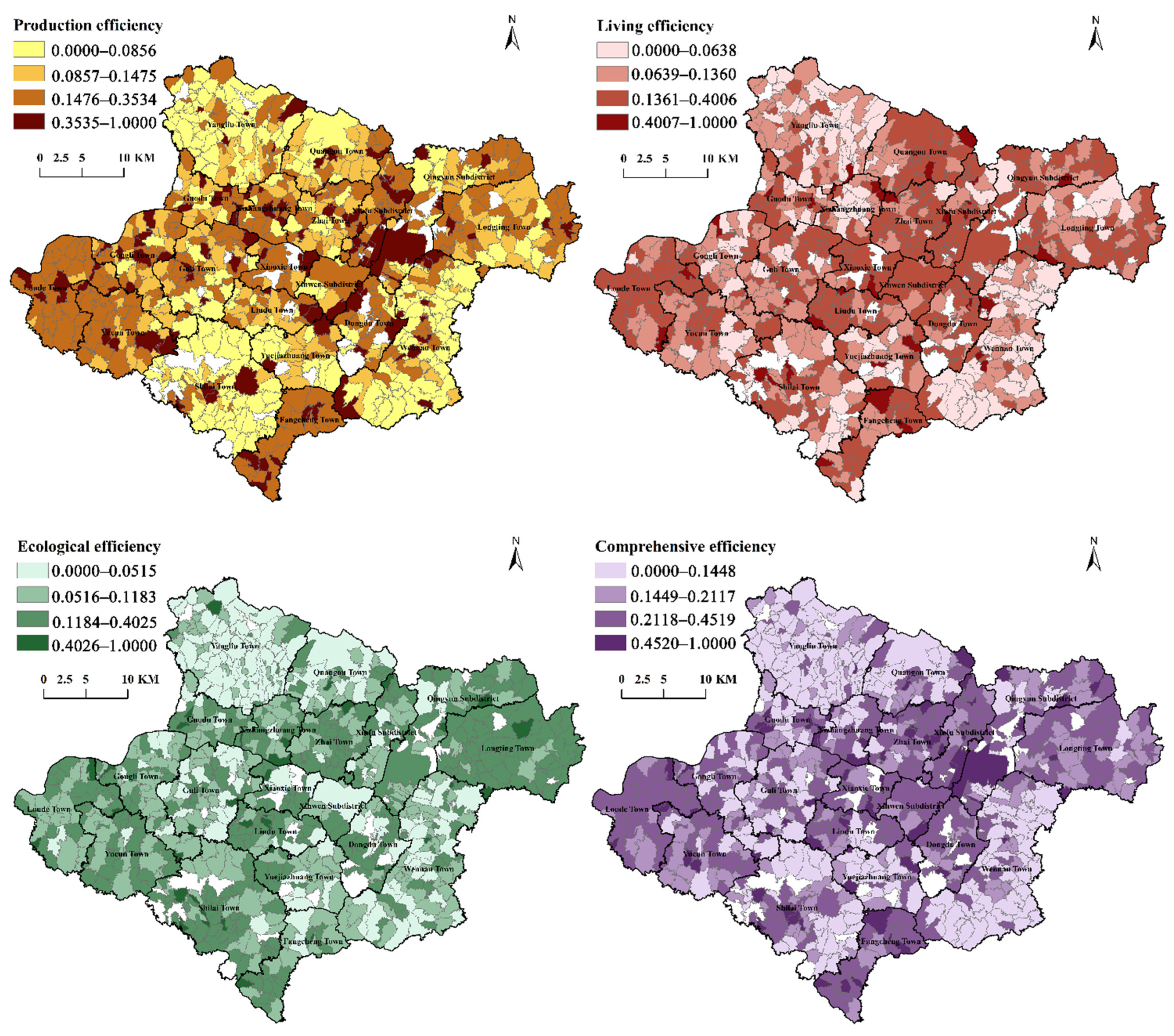
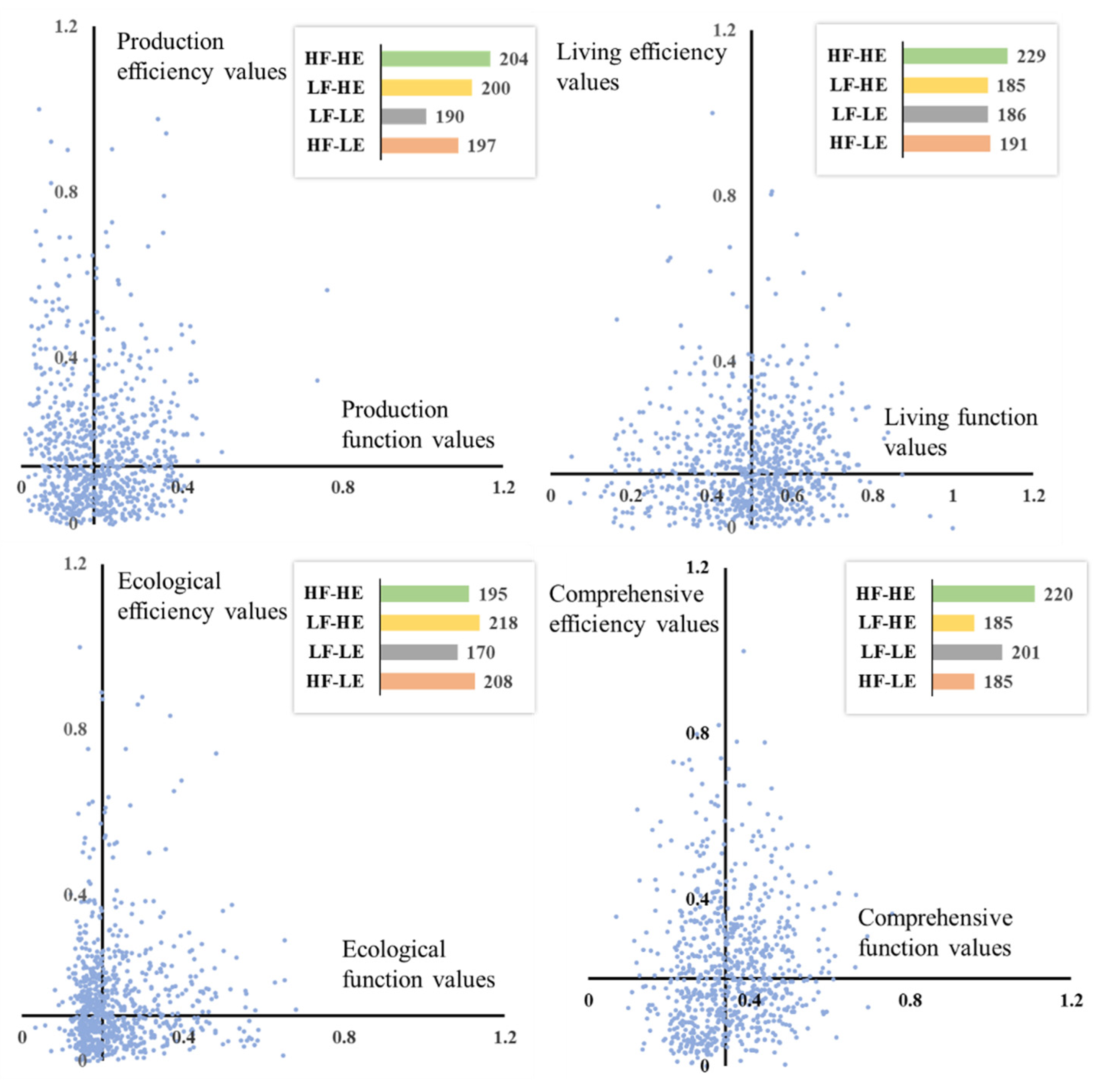
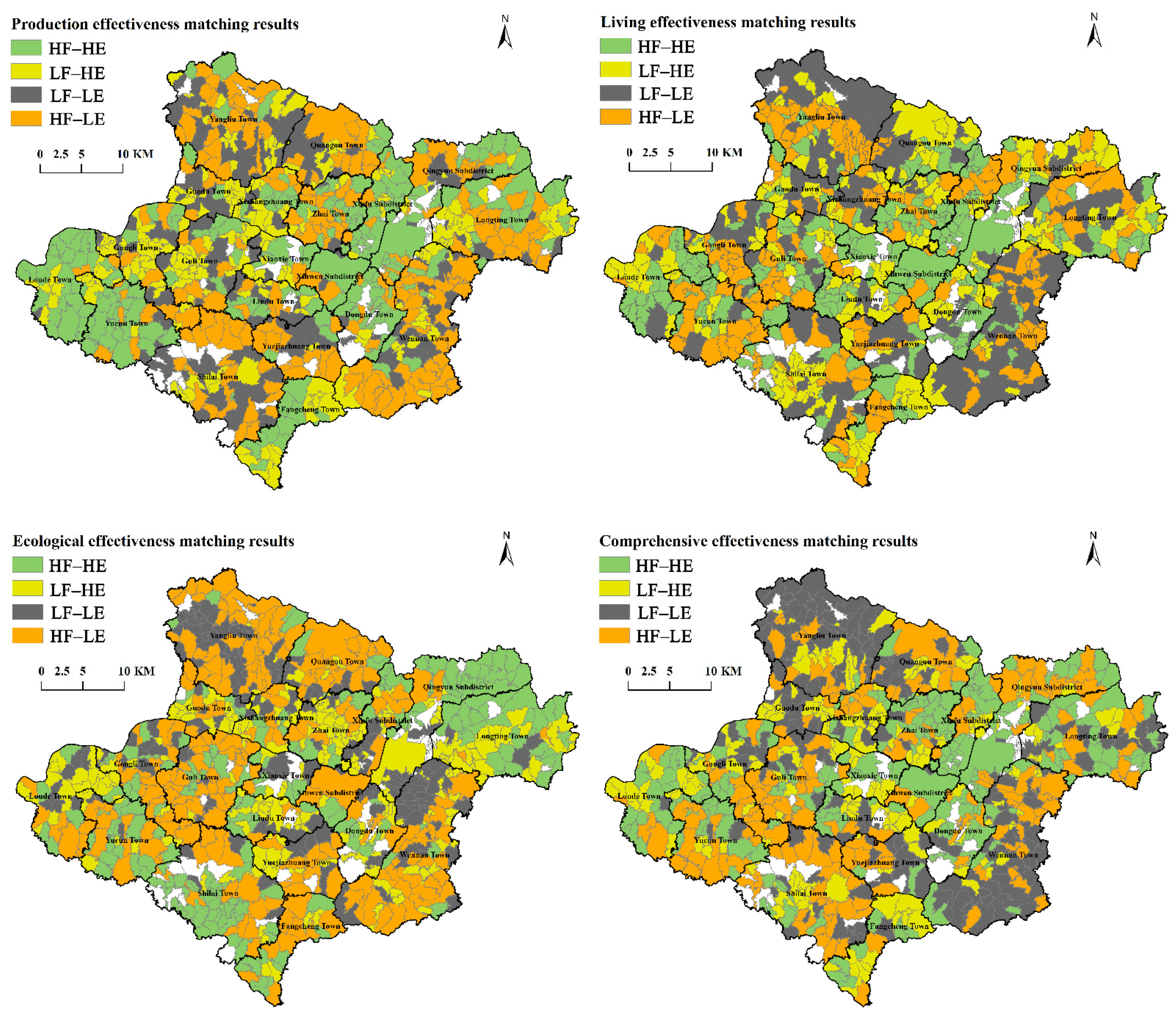
| Target Layer | Indicator Attributes | Indicator | Indicator Explanation | Type of Indicator |
|---|---|---|---|---|
| Production effectiveness | Function | Agricultural land area per capita | Total area of land used for agricultural production/total population of the village | + |
| Number of non-agricultural industries | The number of all type enterprises and individual businesses | + | ||
| Percentage of the village labor force | Number of people working in the village/total population of the village | + | ||
| Disposable income per capita | Average level of the sum money spent and saved by villagers | + | ||
| Efficiency | Agricultural production land area | Area of agricultural land in a village | Input | |
| Scale of land for non-agricultural industries | Total area of non-agricultural industrial land | |||
| Total agricultural production output value | Total agricultural production output value in a village | Output | ||
| Total nonagricultural production output value | Total nonagricultural production output value in a village | |||
| Living effectiveness | Function | Population density | Resident population of the village/total area of the village | + |
| Average household dwelling size | Total area of homestead/total number of households in the village | + | ||
| Residential quality | Proportion of masonry, brick and steel bungalows, self-built buildings, collective construction buildings, and commercial buildings | + | ||
| Transport accessibility | Total road mileage in the village area | + | ||
| Degree of locational advantage | Distance from village center to town center | − | ||
| Efficiency | Financial expenditure funds for the amenities | Financial expenditure funds for the amenities of the village | Input | |
| Living convenience | Average proportion of households with piped water, natural gas to households, central heating, and hardened roads | Output | ||
| Infrastructure, public service enrichment | Number of types of facilities such as fitness facilities, parks, places of worship, and public services provided by the village | |||
| Ecological effectiveness | Function | Natural or geological hazards | Number of geological hazards in 5 years | − |
| Percentage of ecological land | Total area of ecological land in the village, including woodland, grassland, and water/total area of the village | + | ||
| Ecologically harmful industries | Number of industries in the village that are harmful to the ecological and residential environment | − | ||
| Efficiency | Village environmental management costs | Village investment funds for ecological and village environmental management | Input | |
| Proportion of flush toilets | Number of flushing toilets owned by households in the village/total number of households | Output | ||
| Village greenery coverage | Ratio of village green area/total residential area |
| Target Layer | Indicator | Indicator Explanation | Type of Indicator | Weight |
|---|---|---|---|---|
| Production function (0.3706) | Agricultural land area per capita | Total area of land used for agricultural production/total population of the village | + | 0.0912 |
| Number of non-agricultural industries | The number of all type enterprises and individual businesses | + | 0.0901 | |
| Percentage of the village labor force | Number of people working in the village/total population of the village | + | 0.1079 | |
| Disposable income per capita | Average level of the sum money spent and saved by villagers | + | 0.0814 | |
| Living function (0.3695) | Population density | Resident population of the village/total area of the village | + | 0.0735 |
| Average household dwelling size | Total area of homestead/total number of households in the village | + | 0.0786 | |
| Residential quality | Proportion of masonry, brick and steel bungalows, self-built buildings, collective construction buildings, and commercial buildings | + | 0.0663 | |
| Transport accessibility | Total road mileage in the village area | + | 0.0781 | |
| Degree of locational advantage | Distance from village center to town center | − | 0.0730 | |
| Ecological function (0.2599) | Natural or geological hazards | Number of geological hazards in 5 years | − | 0.0582 |
| Percentage of ecological land | Total area of ecological land in the village, including woodland, grassland, and water etc./total area of the village | + | 0.1308 | |
| Ecologically harmful industries | Number of industries in the village that are harmful to the ecological and residential environment | − | 0.0709 |
| Production Function | Living Function | Ecological Function | Production Efficiency | Living Efficiency | Ecological Efficiency | |
|---|---|---|---|---|---|---|
| Production function | — | |||||
| Living function | 0.13 *** | — | ||||
| Ecological function | −0.063 *** | −0.194 | — | |||
| Production efficiency | −0.072 *** | −0.106 | −0.01 * | — | ||
| Living efficiency | −0.011 *** | −0.074 | −0.044 | 0.079 *** | — | |
| Ecological efficiency | 0.005 *** | −0.057 | −0.007 ** | −0.043 *** | 0.087 *** | — |
Publisher’s Note: MDPI stays neutral with regard to jurisdictional claims in published maps and institutional affiliations. |
© 2022 by the authors. Licensee MDPI, Basel, Switzerland. This article is an open access article distributed under the terms and conditions of the Creative Commons Attribution (CC BY) license (https://creativecommons.org/licenses/by/4.0/).
Share and Cite
Wang, Y.; Cheng, L.; Zheng, Y. Rural Effectiveness Evaluation: A New Way of Assessing Village Development Status. Sustainability 2022, 14, 9059. https://doi.org/10.3390/su14159059
Wang Y, Cheng L, Zheng Y. Rural Effectiveness Evaluation: A New Way of Assessing Village Development Status. Sustainability. 2022; 14(15):9059. https://doi.org/10.3390/su14159059
Chicago/Turabian StyleWang, Yifang, Linlin Cheng, and Yang Zheng. 2022. "Rural Effectiveness Evaluation: A New Way of Assessing Village Development Status" Sustainability 14, no. 15: 9059. https://doi.org/10.3390/su14159059
APA StyleWang, Y., Cheng, L., & Zheng, Y. (2022). Rural Effectiveness Evaluation: A New Way of Assessing Village Development Status. Sustainability, 14(15), 9059. https://doi.org/10.3390/su14159059







